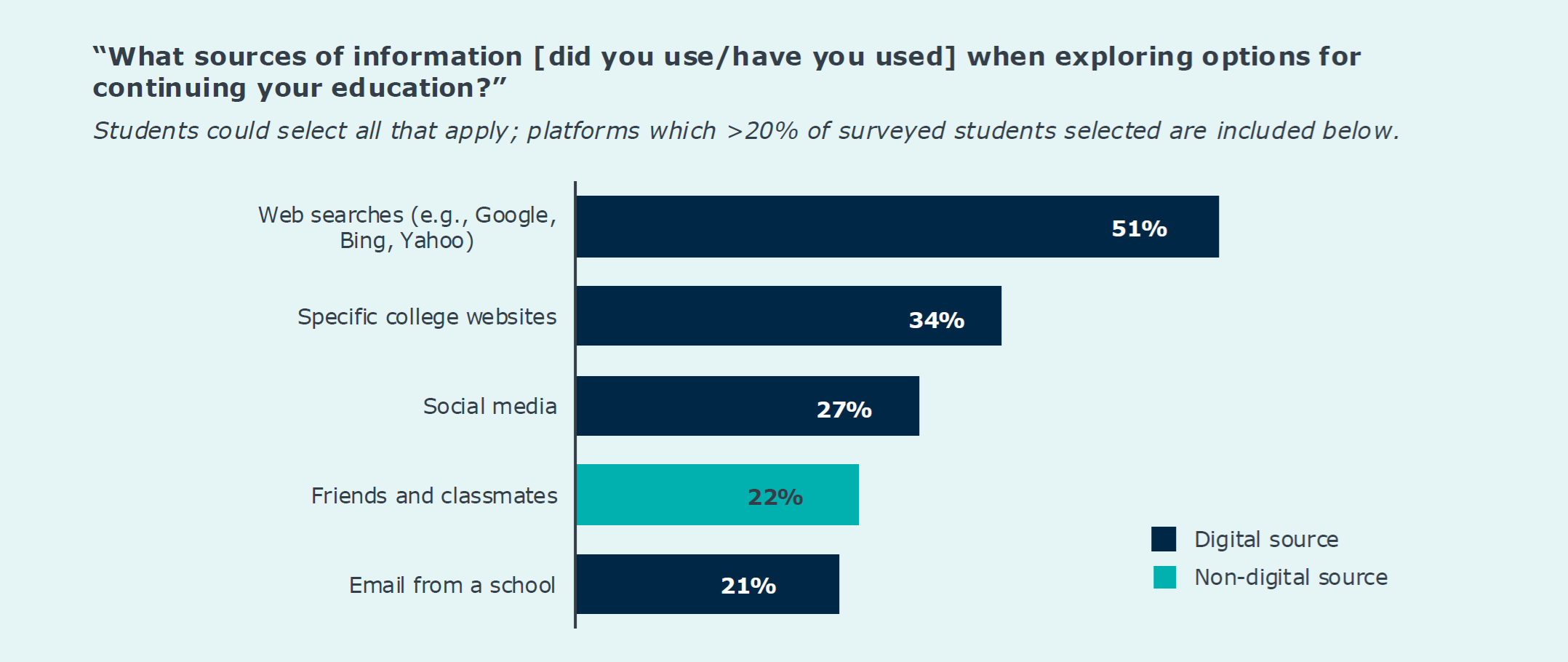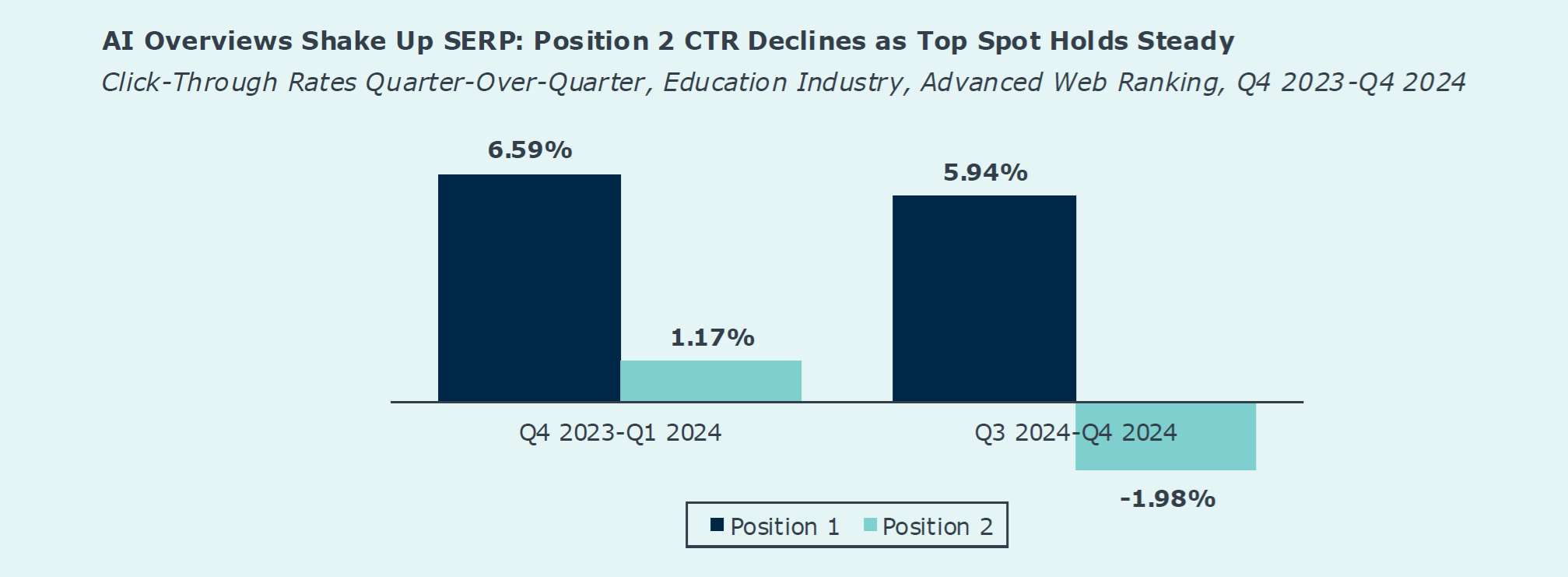Your digital marketing strategy is probably outdated—here’s how to fix it
According to EAB’s latest Adult Learner Recruitment survey, four of the top five information sources students use to discover programs are digital. Search engines, college websites, and even social media rank far above traditional methods.

But today’s most successful strategies look nothing like the ones that worked five—even two—years ago. Even institutions with healthy marketing budgets are finding themselves falling behind thanks to shifting social media behaviors, AI-disrupted search results, and a rise in bot activity that’s quietly draining ad spend and distorting campaign data.
If you’re still relying on outdated playbooks to identify high-intent graduate and adult learners, now’s the time to pivot. Below, I’ll break down what’s changed and what to do about it.
Social media: From micro-targeting to familiarity at scale
Once upon a time, social media platforms were the holy grail of lead generation. You could serve an ad to a 32-year-old parent within a 10-mile radius who had a bachelor’s degree and was recently job hunting. That level of specificity ended in the wake of the Cambridge Analytica scandal, which ushered in a new era of data privacy laws and limited targeting capabilities. In response, prospective students have become more cautious in their search behavior, withholding personal information unless the value exchange is clear and compelling.

Today’s social media platforms are less about micro-targeting and more about showing up consistently in the right places with the right tone. Think of social media as your brand’s storefront, not your lead funnel.
Here’s how to adapt:
- Go omnichannel. Ensure you’re consistent, personalized, and integrated messaging—no matter the channel—that work in concert to move the student smoothly through the journey.
- Tailor your content. Today’s prospective students are digital natives who expect to receive the right message at the right time. Your content must be strategic, platform-aware, and relevant.
- Use student influencers. Prospects trust their peers more than your .edu handle. Student creators bring authenticity and keep you current with trends and tone.
- Rethink success metrics. Focus less on direct conversions and more on engagement, reach, and sentiment. Familiarity builds trust, and trust drives applications, eventually.
Monitor and Optimize Lead Performance
SEO: Adapt to the age of AI summaries and zero-click searches
AI search has fundamentally changed the rules of search optimization. And if your strategy still hinges on ranking for keywords like “online MBA program,” you’re already behind.
AI-powered search features, including Google’s AI Overview, Featured Snippets, and People Also Ask, are just a few ways in which student search and click behavior is being reshaped. Students now search like they talk, asking questions such as, “What are the best part-time MBA programs for working professionals in healthcare administration?” and expecting instant, useful answers.
For higher education, the impact can be especially unforgiving: school websites that don’t appear in an AI summary or hold the #1 spot on a search engine results page (SERP) are seeing steep declines in click-through rates (CTR), while position 1 results continue to perform steadily.

And while your .edu site remains a critical resource for graduate prospects, the way students access that information is shifting. In 2020, 72% of adult learners visited specific school websites of each school they were considering. By 2024, that number had dropped to just 34%. If you’re not visible to AI search tools, you’re not visible to prospects.
To stay visible, your SEO strategy needs to evolve:
- Traditional SEO is no longer enough. If your content isn’t structured for AI inclusion, featured in summaries, or cited in Overviews, it’s not part of the decision journey.
- Audit content for AI visibility. Identify where you’re losing ground to AI Overviews and restructure content to be semantically rich, clearly formatted, and citation friendly. Machines need clarity, not just keywords.
- Think conversational. Optimize your content for real questions, not just keywords. Use blog posts, FAQs, and program pages to answer what students are actually asking.
- Prioritize quality. Google rewards expert, original, and helpful content. Collaborate with faculty and advisors to ensure your pages reflect credible, human insights.
- Keep it fresh. Regularly update your program pages and blog content. Stale content won’t rank, and it certainly won’t convert.
Watch the On-Demand Webinar for More Strategies
Bot mitigation: The problem you didn’t know you had
Bot traffic isn’t just an annoyance—it’s a budget killer. In the education sector, 24% of web traffic is driven by malicious bots. They click on ads, fill out lead forms and applications, and inflate your metrics, all without representing a single real prospective student.
Even more troubling? These bots can bypass simple detection tools and cause long-term damage to your CRM data, skew your campaign results, and even expose your institution to security risks.
Bot Activity by the Numbers1
- +12% Percentage of bot traffic increased nearly 12% from 2018 to 2023
- 24% of internet traffic in the education industry is made up of malicious bot activity
- $100B+ of advertising money is lost each year due to bot activity
1. Sources: Barracuda, Imperva
Here’s how to protect your digital investment:
- Analyze click patterns. Repeated clicks within seconds? That’s not human behavior. Watch for rhythmic or impossibly fast engagement.
- Check user agents. Most bots reveal themselves through identifiable browser fingerprints. Flag and filter known bot agents.
- Use honeypots. Embed invisible links in emails. Bots will click them, real humans won’t. It’s a quiet but effective filter.
- Add reCAPTCHA. These low-lift tests are one of the easiest ways to block bots before they can hit your forms or fake-convert on landing pages.
Connect with verified, high-quality leads with Appily Advance
Even with a strong digital strategy, generating high-intent leads can feel like playing defense. Targeted lead acquisition sources such as Appily Advance—built to identify right-fit graduate and adult learners—can save your team valuable time and resources, letting you can focus on what matters most: engaging leads and guiding them to enrollment.
Final takeaways
The digital rules have changed, but your strategy doesn’t have to fall behind. Here’s your new checklist:
- Use social media to build familiarity, not just clicks
- Upskill your SEO strategy to answer real student questions and become AI visible
- Prioritize mobile UX and regular content updates
- Guard your data and budget against bots
- Partner with services like Appily Advance to boost lead quality

More Blogs

AI visibility is critical when competing for student enrollments

When Grad PLUS disappears: What 8,000+ grad students said about paying for school
